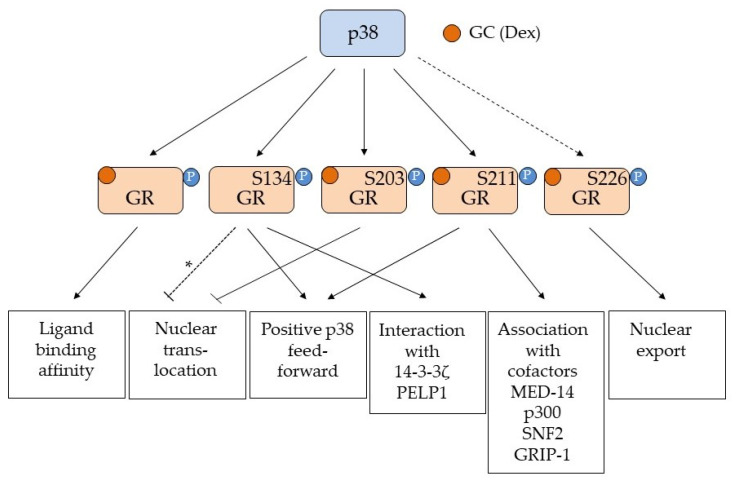Figure 1.
Overview of the GR phosphorylation sites affected by p38 MAPK. Serine (S) 134, 203 and 211 are all phosphorylation sites shown to be affected by p38 MAPK activation. Serine (S) 226 is a JNK phosphorylation site known to enhance nuclear export [36] and is indicated (but not convincingly proven) to be a p38 MAPK phospho site [37,38,39] (stippled line). The various responses to the individual p38 phosphorylation events are shown in the boxes below. Arrows indicate activation/positive regulation, while a blunted line indicates inhibition. The GR ligand is indicated as GC (glucocorticoid) and Dex (Dexamethasone). For S134, a phosphorylation by AKT1 is reported to prevent nuclear translocation [43], but since this is not proven to be the effect of p38 phosphorylation of this site, it is marked with a stippled line with an asterisk (*). p38-dependent phosphorylation of unspecified residues in GR affects ligand binding [31], while pS134 is shown to be ligand independent and to generate a positive feed forward loop with p38 [33] as well as promoting interaction with 14-3-3ζ [40,42] and PELP1 [41]. p38 dependent phosphorylation of S203 prevents nuclear translocation [35], while pS211 is associated with ligand bound and activated GR and are important for GR’s interaction with transcriptional co-factors such as MED-14 [49], p300 [34], SNF2 [34] and GRIP-1 [51]. GR pS211 will also contribute to a positive feed forward loop with p38 [42]. The sum of all these phosphorylation events will affect the transcriptional regulation exerted by GR. Importantly the phosphorylation of S203, S211 and S226 seem to influence each other, and the relationship between the phosphorylation events for pS203 and pS211 [32,35,51] and pS211 and pS226 [48,49] will contribute to the selection of genes transcribed by GR in a cell and tissue specific manner.

